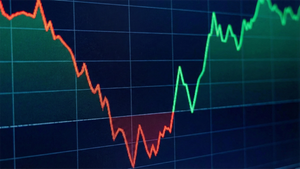
Telecommunications company Dycom (NYSE: DY) reported Q4 CY2024 results beating Wall Street’s revenue expectations, with sales up 13.9% year on year to $1.08 billion. On the other hand, next quarter’s revenue guidance of $1.18 billion was less impressive, coming in 5.6% below analysts’ estimates. Its GAAP profit of $1.11 per share was 33.3% above analysts’ consensus estimates.
Is now the time to buy Dycom? Find out by accessing our full research report, it’s free.
Dycom (DY) Q4 CY2024 Highlights:
- Revenue: $1.08 billion vs analyst estimates of $1.03 billion (13.9% year-on-year growth, 5.7% beat)
- EPS (GAAP): $1.11 vs analyst estimates of $0.83 (33.3% beat)
- Adjusted EBITDA: $116.4 million vs analyst estimates of $103.8 million (10.7% margin, 12.1% beat)
- Revenue Guidance for Q1 CY2025 is $1.18 billion at the midpoint, below analyst estimates of $1.25 billion
- EPS (GAAP) guidance for Q1 CY2025 is $1.62 at the midpoint, missing analyst estimates by 13.1%
- EBITDA guidance for Q1 CY2025 is $135.6 million at the midpoint, below analyst estimates of $146.3 million
- Operating Margin: 10%, up from 4.5% in the same quarter last year
- Market Capitalization: $5.02 billion
“Dycom’s strong fourth quarter and fiscal year results reflect the successful execution of our strategy and our ability to meet growing industry demand while sustaining the highest level of quality in our work,” said Dan Peyovich, Dycom’s President and Chief Executive Officer.
Company Overview
Working alongside some of the most popular mobile carriers in the world, Dycom (NYSE: DY) builds and maintains telecommunications infrastructure.
Engineering and Design Services
Companies providing engineering and design services boast ever-evolving technical expertise. Compared to their counterparts who manufacture and sell physical products, these companies can also pivot faster to more trending areas due to their smaller physical asset bases. Green energy and water conservation, for example, are current themes driving incremental demand in this space. On the other hand, those providing engineering and design services are at the whim of construction and infrastructure project volumes, which tend to be cyclical and can be impacted heavily by economic factors such as interest rates.
Sales Growth
A company’s long-term performance is an indicator of its overall quality. While any business can experience short-term success, top-performing ones enjoy sustained growth for years. Unfortunately, Dycom’s 7.1% annualized revenue growth over the last five years was mediocre. This wasn’t a great result compared to the rest of the industrials sector, but there are still things to like about Dycom.
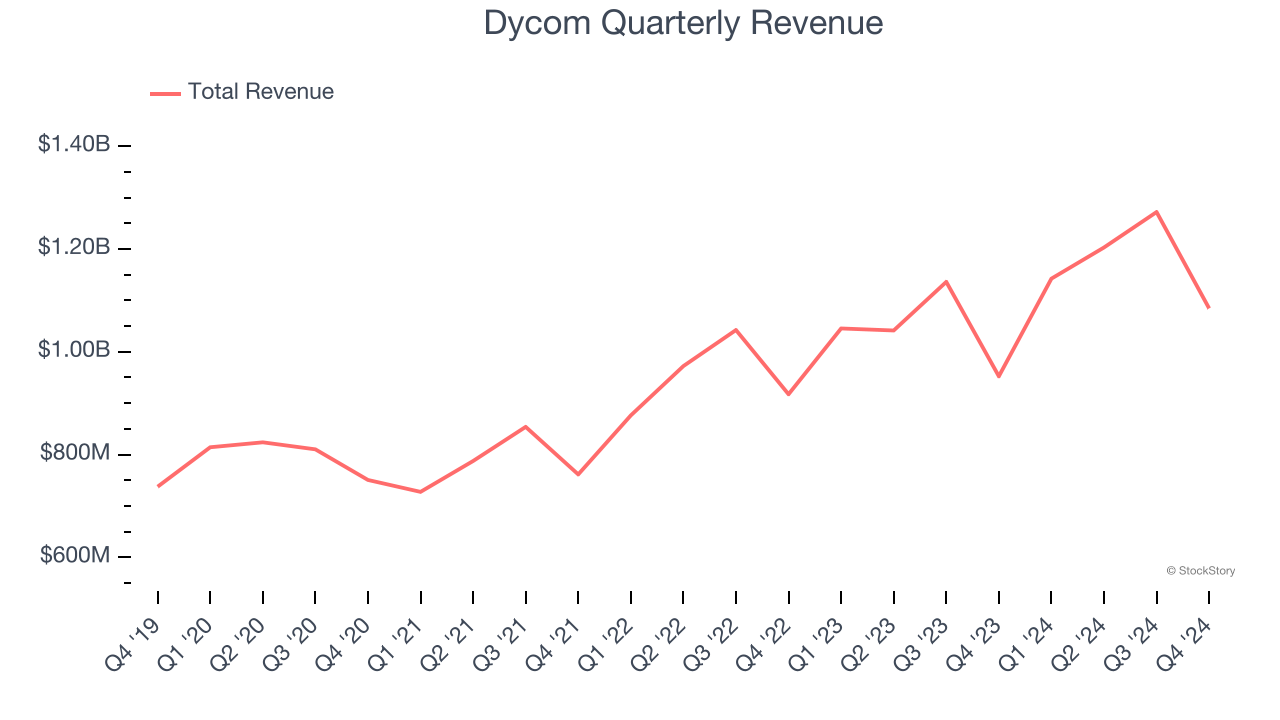
We at StockStory place the most emphasis on long-term growth, but within industrials, a half-decade historical view may miss cycles, industry trends, or a company capitalizing on catalysts such as a new contract win or a successful product line. Dycom’s annualized revenue growth of 11.1% over the last two years is above its five-year trend, suggesting its demand recently accelerated. 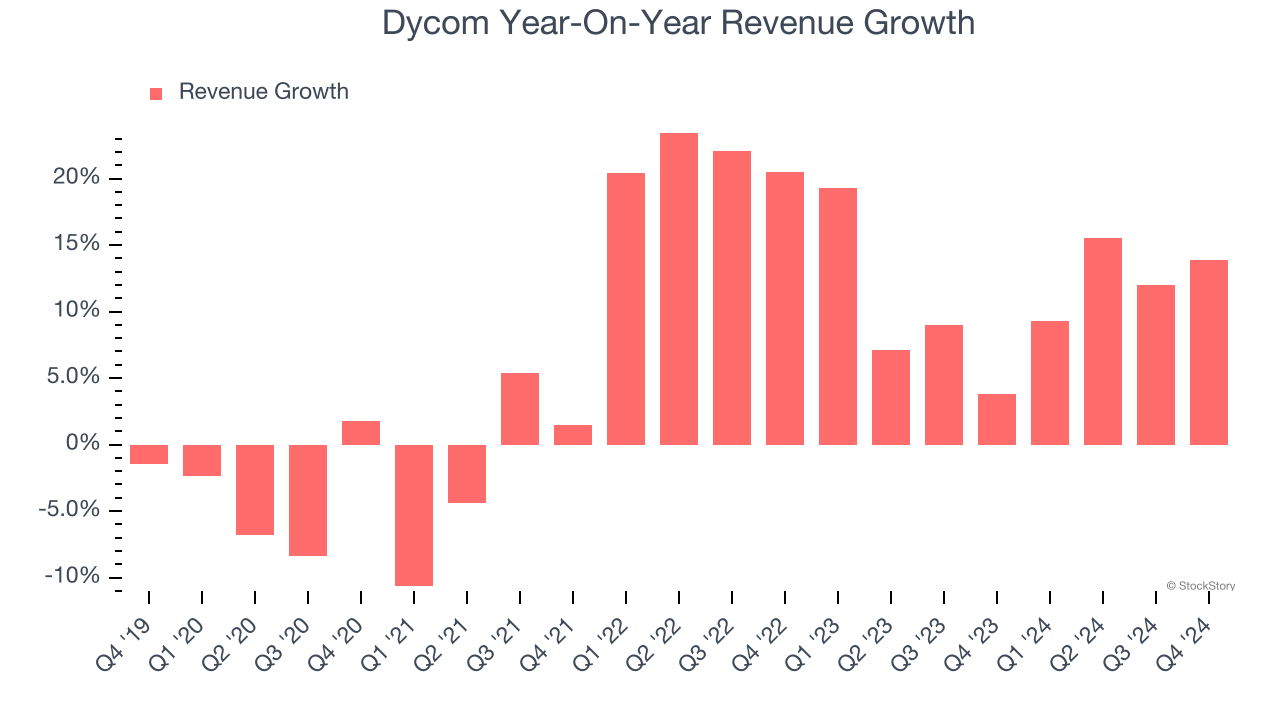
This quarter, Dycom reported year-on-year revenue growth of 13.9%, and its $1.08 billion of revenue exceeded Wall Street’s estimates by 5.7%. Company management is currently guiding for a 3.3% year-on-year increase in sales next quarter.
Looking further ahead, sell-side analysts expect revenue to grow 12.5% over the next 12 months, similar to its two-year rate. This projection is healthy and suggests its newer products and services will fuel better top-line performance.
Here at StockStory, we certainly understand the potential of thematic investing. Diverse winners from Microsoft (MSFT) to Alphabet (GOOG), Coca-Cola (KO) to Monster Beverage (MNST) could all have been identified as promising growth stories with a megatrend driving the growth. So, in that spirit, we’ve identified a relatively under-the-radar profitable growth stock benefiting from the rise of AI, available to you FREE via this link.
Operating Margin
Operating margin is one of the best measures of profitability because it tells us how much money a company takes home after procuring and manufacturing its products, marketing and selling those products, and most importantly, keeping them relevant through research and development.
Dycom was profitable over the last five years but held back by its large cost base. Its average operating margin of 5.7% was weak for an industrials business. This result isn’t too surprising given its low gross margin as a starting point.
On the plus side, Dycom’s operating margin rose by 6.3 percentage points over the last five years, as its sales growth gave it immense operating leverage.
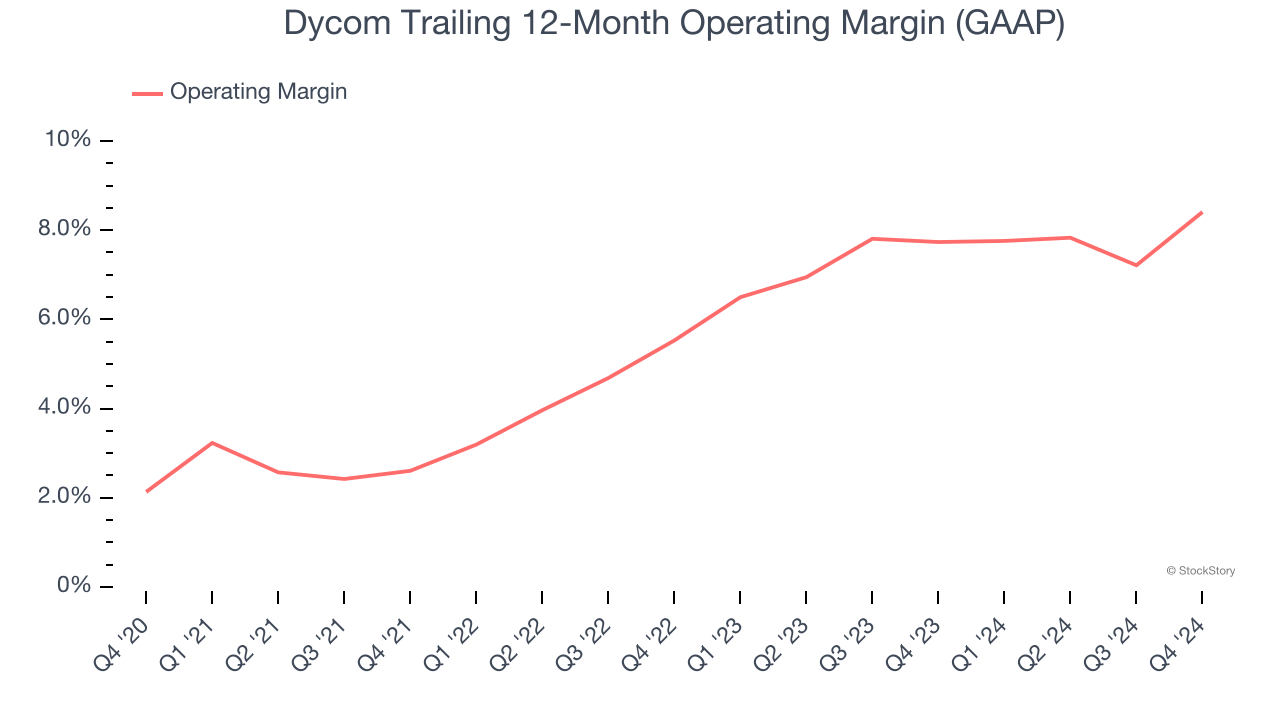
This quarter, Dycom generated an operating profit margin of 10%, up 5.5 percentage points year on year. The increase was solid, and since its operating margin rose more than its gross margin, we can infer it was recently more efficient with expenses such as marketing, R&D, and administrative overhead.
Earnings Per Share
Revenue trends explain a company’s historical growth, but the long-term change in earnings per share (EPS) points to the profitability of that growth – for example, a company could inflate its sales through excessive spending on advertising and promotions.
Dycom’s EPS grew at an astounding 34.6% compounded annual growth rate over the last five years, higher than its 7.1% annualized revenue growth. This tells us the company became more profitable on a per-share basis as it expanded.
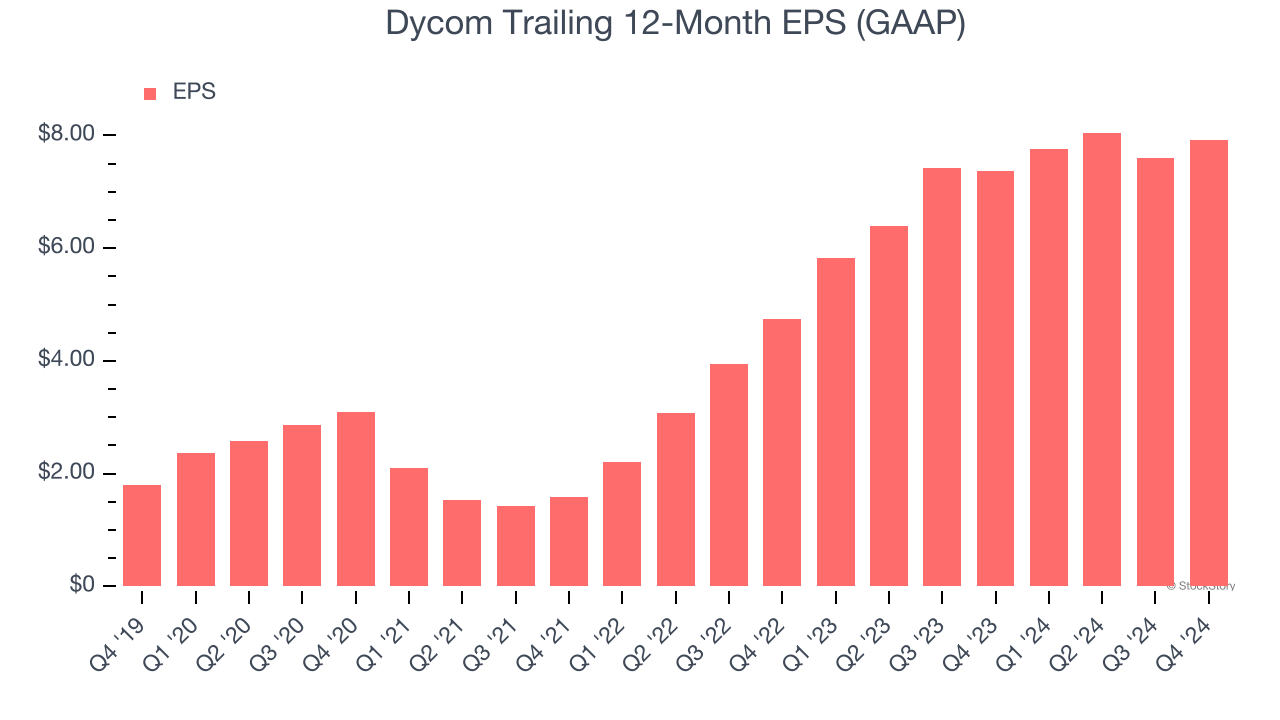
Diving into Dycom’s quality of earnings can give us a better understanding of its performance. As we mentioned earlier, Dycom’s operating margin expanded by 6.3 percentage points over the last five years. On top of that, its share count shrank by 6.6%. These are positive signs for shareholders because improving profitability and share buybacks turbocharge EPS growth relative to revenue growth. 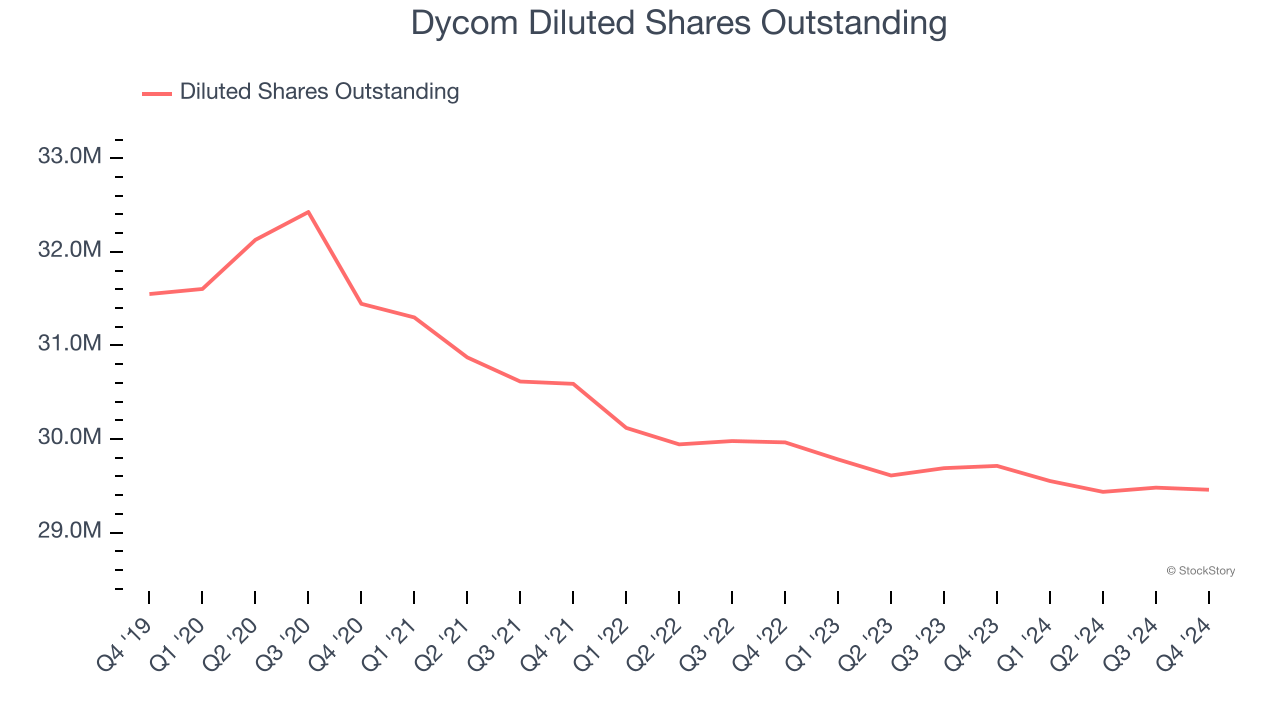
Like with revenue, we analyze EPS over a shorter period to see if we are missing a change in the business.
For Dycom, its two-year annual EPS growth of 29.2% was lower than its five-year trend. We still think its growth was good and hope it can accelerate in the future.
In Q4, Dycom reported EPS at $1.11, up from $0.79 in the same quarter last year. This print easily cleared analysts’ estimates, and shareholders should be content with the results. Over the next 12 months, Wall Street expects Dycom’s full-year EPS of $7.92 to grow 21.5%.
Key Takeaways from Dycom’s Q4 Results
We were impressed that Dycom handily beat analysts’ revenue, EBITDA, and EPS expectations this quarter. On the other hand, its revenue and EBITDA guidance for next quarter fell short of Wall Street’s estimates. The market seems to be forgiving this guidance miss, and the stock traded up 5% to $180 immediately after reporting.
Indeed, Dycom had a rock-solid quarterly earnings result, but is this stock a good investment here? When making that decision, it’s important to consider its valuation, business qualities, as well as what has happened in the latest quarter. We cover that in our actionable full research report which you can read here, it’s free.


